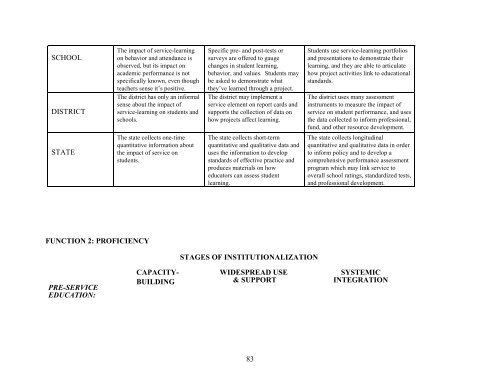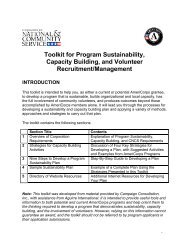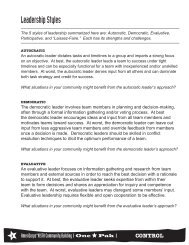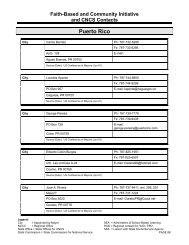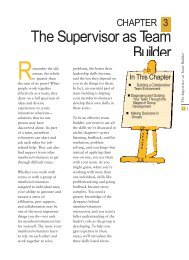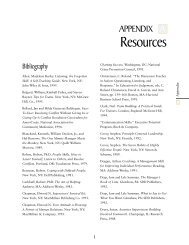MAKE IT LAST FOREVER: THE ... - National Service Resource Center
MAKE IT LAST FOREVER: THE ... - National Service Resource Center
MAKE IT LAST FOREVER: THE ... - National Service Resource Center
You also want an ePaper? Increase the reach of your titles
YUMPU automatically turns print PDFs into web optimized ePapers that Google loves.
SCHOOL<br />
DISTRICT<br />
STATE<br />
FUNCTION 2: PROFICIENCY<br />
PRE-SERVICE<br />
EDUCATION:<br />
The impact of service-learning<br />
on behavior and attendance is<br />
observed, but its impact on<br />
academic performance is not<br />
specifically known, even though<br />
teachers sense it’s positive.<br />
The district has only an informal<br />
sense about the impact of<br />
service-learning on students and<br />
schools.<br />
The state collects one-time<br />
quantitative information about<br />
the impact of service on<br />
students.<br />
CAPAC<strong>IT</strong>Y-<br />
BUILDING<br />
Specific pre- and post-tests or<br />
surveys are offered to gauge<br />
changes in student learning,<br />
behavior, and values. Students may<br />
be asked to demonstrate what<br />
they’ve learned through a project.<br />
The district may implement a<br />
service element on report cards and<br />
supports the collection of data on<br />
how projects affect learning.<br />
The state collects short-term<br />
quantitative and qualitative data and<br />
uses the information to develop<br />
standards of effective practice and<br />
produces materials on how<br />
educators can assess student<br />
learning.<br />
STAGES OF INST<strong>IT</strong>UTIONALIZATION<br />
WIDESPREAD USE<br />
& SUPPORT<br />
83<br />
Students use service-learning portfolios<br />
and presentations to demonstrate their<br />
learning, and they are able to articulate<br />
how project activities link to educational<br />
standards.<br />
The district uses many assessment<br />
instruments to measure the impact of<br />
service on student performance, and uses<br />
the data collected to inform professional,<br />
fund, and other resource development.<br />
The state collects longitudinal<br />
quantitative and qualitative data in order<br />
to inform policy and to develop a<br />
comprehensive performance assessment<br />
program which may link service to<br />
overall school ratings, standardized tests,<br />
and professional development.<br />
SYSTEMIC<br />
INTEGRATION


